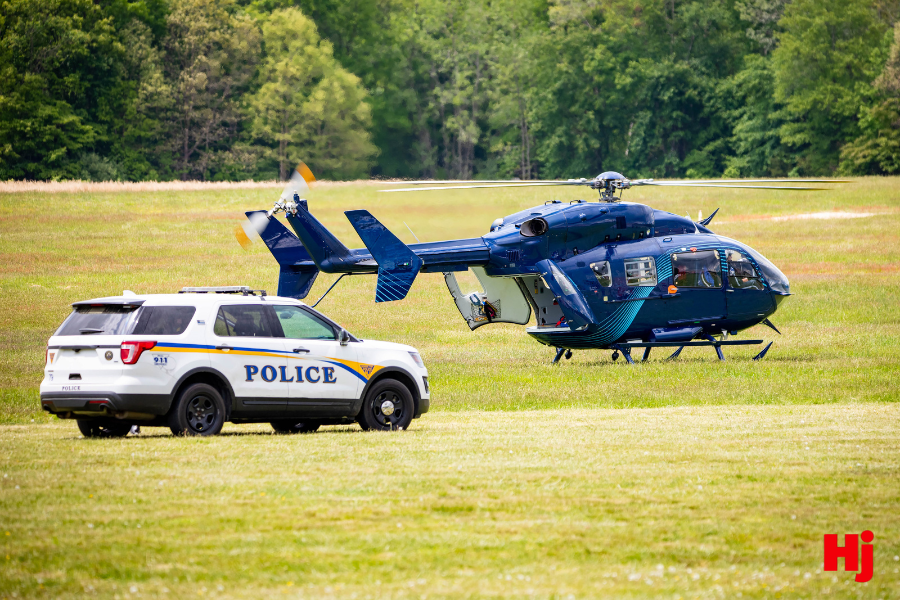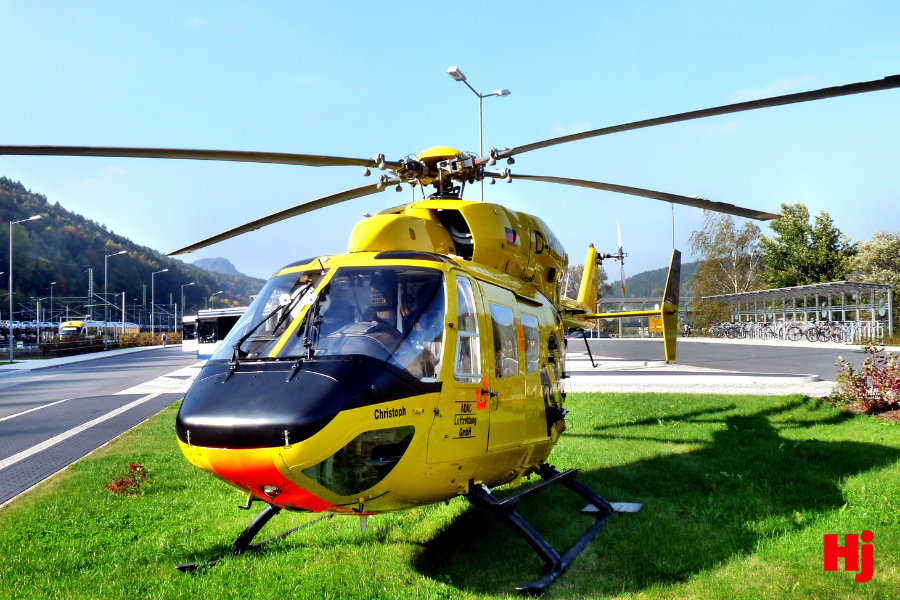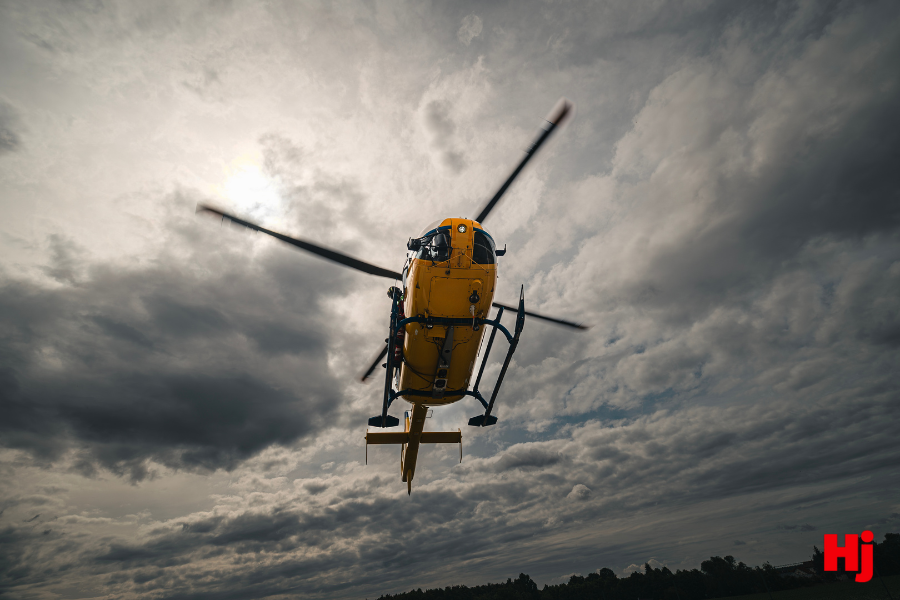Emergency Medical Services (HEMS) - Enhanced Guide
In Part 1 of our guide to becoming a helicopter pilot in the United States, we discussed the training and certification required to enter the profession. This section begins our exploration of the industry sectors where helicopter pilots are employed, starting with Helicopter Emergency Medical Services (HEMS). As a critical component of the healthcare and public safety system, HEMS operations require a high level of technical proficiency, sound aeronautical decision-making, and the ability to perform under pressure. From accident scenes to interfacility transfers, HEMS pilots are responsible for safely transporting patients and medical crews in time-sensitive, often challenging conditions. This section outlines the operational environment, qualifications, and career outlook for pilots seeking to work in this demanding and essential field.

Major EMS Helicopter Operators
Understanding the landscape of HEMS employment begins with knowing the key players in the industry. The following operators represent the largest and most established companies, each offering distinct advantages in terms of fleet diversity, geographic coverage, and career development opportunities. These companies not only provide the majority of HEMS jobs but also set industry standards for compensation, training, and operational procedures.
Air Methods Corporation
As the largest air medical provider in the United States, Air Methods operates over 450 aircraft from more than 300 bases across 48 states. The company serves more than 100,000 patients annually and is affiliated with leading healthcare systems nationwide. Air Methods also owns notable tourism operators like Blue Hawaiian and Sundance Helicopters.
Fleet: Bell 407, Bell 429, Airbus EC135/EC145, AS350, EC130 plus fixed-wing aircraft
Notable Brands: Mercy Air (CA/NV), LifeNet, AirLife, Airlift NW
Current Pay Scale: $82,900 - $93,251 annually (VFR positions)
Additional Incentives:
- Sign-on bonuses up to $20,000
- Annual stipends up to $20,000
- Off-duty housing provided
- 120% ACCRA location adjustments in some markets
- Retention bonuses frequently offered
PHI Air Medical
Part of the broader PHI Aviation Group, PHI Air Medical is one of the longest-operating EMS providers in the country. Known for its extensive fleet and global operations, PHI serves both public and private healthcare networks across the U.S.
Fleet: Airbus AS350, Bell 407, EC135, EC145, and fixed-wing aircraft
Additional Incentives: PHI commonly provides sign-on bonuses and retention bonuses of up to $100,000, along with annual stipends for certain bases.
Air Evac LifeTeam
Operating more than 150 helicopter air ambulance bases across 18 states, Air Evac LifeTeam is a subsidiary of Global Medical Response (GMR) and serves primarily rural communities. The organization has built its reputation on providing critical care transport to underserved areas.
Fleet: Bell 206, Bell 407, AS350, EC130, EC135
Current Salary Range: $77,151 - $89,595 annually (industry reported averages)
Work Schedule: 7 days on / 7 days off
Additional Incentives: Part of GMR family offering retention bonuses up to $40,000 depending on location
REACH Air Medical Services
Primarily focused on the Western U.S., REACH provides rapid response and interfacility air medical transport. Their bases are strategically located to support both rural and urban regions, especially in California, Oregon, and Arizona.
Fleet: Bell 407, Airbus EC130/135/145, AS350, fixed-wing aircraft
Additional Incentives: REACH regularly offers sign-on bonuses and annual stipends, and along with the other GMR family of companies, offers a retention bonus of $40,000 depending on location.
Life Flight Network
Operating across the Pacific Northwest and Intermountain West, Life Flight Network offers 24/7/365 emergency air and ground transport. Their services extend into Idaho, Oregon, Washington, Montana, and Hawaii, with growing partnerships in California and Nevada.
Fleet: Bell 407, Bell 429, EC135, EC145, and fixed-wing aircraft
Current Requirements: 2,000 hours total time, 1,500 hours PIC, 1,000 hours turbine
Benefits: LFN prides itself on an extensive list of employee benefits described as well above industry standard, including:
- 100% company-paid medical, dental, vision, life insurance
- 401(k) with 100% vested employer contribution
- Generous PTO starting at almost 4 weeks annually
- $15,000 sign-on bonus for eligible positions
Med-Trans Corporation
With more than 100 aircraft, Med-Trans is a national provider of emergency air medical transport. The company specializes in both adult and pediatric critical care services and is one of the world's largest operators of the Bell 407.
Fleet: Bell 407, H125, EC130, EC135, EC145, and H155
Additional Incentives: Med-Trans regularly offers sign-on bonuses and annual stipends, and currently a retention bonus of $40,000 depending on location.
Metro Aviation
Unique in its dual role as an operator and aircraft completion center, Metro Aviation manages more than 130 aircraft for over 30 programs in 18 states. The company outfits its own aircraft with custom avionics and medical configurations, making it a top-tier provider of turnkey EMS solutions.
Fleet: Bell 407, Airbus EC135/145, AS350
Current Incentives: $2,000 sign-on bonus, $5,000 retention bonus
Specialty: In-house maintenance and customization, hospital-based EMS programs
Requirements: 2,000 hours total time, 1,200 helicopter hours, 1,000 PIC helicopter time
Geisinger Life Flight
Operating primarily in Pennsylvania, Geisinger provides comprehensive air medical services with competitive compensation packages.
Current Pay: Not specified, but includes $25,000 sign-on bonus
Requirements: 2,000 hours total time (or 1,500 with ATP rating), 1,500 helicopter hours, 1,000 PIC
Work Schedule: 7 days on / 7 days off
Benefits: Comprehensive benefits starting day one, including health insurance, tuition reimbursement up to $5,000 annually
Survival Flight
Operating throughout Oklahoma and surrounding regions, Survival Flight maintains high safety standards with CAMTS and NAAMTA Global accreditations.
Fleet: Bell 407
Current Salary: $85,000 - $92,000 base salary
Incentives:
- $15,000 sign-on bonus
- $25,000 retention bonus (paid over first 24 months)
- $15,000 pilot referral bonus
- Off-duty housing provided
Requirements: 2,000 hours total time, 1,500 hours PIC, 500 hours turbine
Qualifying for HEMS Employment
While the operators above represent attractive career destinations, securing employment with these companies requires meeting stringent experience and certification standards. The demanding nature of EMS operations—from night flying to confined area landings under pressure—necessitates a level of experience that goes well beyond basic commercial pilot requirements. Understanding these qualifications early in your career planning will help you develop a targeted approach to building the necessary flight time and skills.
Experience Requirements for EMS Pilots
Due to the demanding nature of EMS work, employers generally require:
Minimum Flight Time:
- Total Time: 1,500–2,500+ flight hours (most common: 2,000 hours)
- Helicopter Time: 1,200–1,500 hours minimum
- Pilot-in-Command: 1,000–1,500 hours helicopter PIC
- Turbine Time: 500–1,000 hours helicopter turbine experience
- Cross Country: 500 hours minimum
- Night Time: 100 hours (50 hours unaided minimum)
- Instrument Time: 75–100 hours (minimum 50 hours in actual flight)
Certificates and Licenses:
- Commercial rotorcraft license with instrument rating (IFR)
- ATP rating preferred by many operators
- First or Second Class FAA medical certificate
- Clean driving record and ability to pass DOT physical
Preferred Qualifications:
- Night Vision Goggle (NVG) experience (often required)
- Previous EMS or public safety flying experience
- Mountain flying experience (location dependent)
- Single Pilot IFR operations experience
- Bachelor's degree (preferred but not always required)
Additional training in water landings, weather avoidance, and confined area operations is often provided during onboarding.
Financial Rewards and Compensation Structure
Meeting these demanding qualifications leads to some of the most competitive compensation packages in the helicopter industry. The combination of specialized skills, irregular schedules, and life-critical responsibilities commands premium pay rates that often exceed those found in other civilian helicopter sectors. Beyond base salaries, the current pilot shortage has created an environment where operators compete aggressively through signing bonuses, retention incentives, and comprehensive benefits packages.
Current Salary and Benefits Analysis (2025)
Base Salary Ranges:
- Entry-Level EMS Pilots: $68,000–$85,000 annually
- Experienced Pilots: $85,000–$120,000+ base salary
- Total Compensation: Can exceed $150,000–$235,000 with overtime, bonuses, and benefits
Geographic Variations:
- Higher cost-of-living areas (California, Northeast): 20-40% premium
- Rural/remote locations: Additional stipends and housing benefits
- Location adjustment factors (ACCRA) up to 120% in some markets
Current Incentive Packages (2025):
- Sign-on Bonuses: $2,000–$25,000 (most common: $15,000–$20,000)
- Retention Bonuses: $5,000–$100,000 (typically $25,000–$40,000)
- Annual Stipends: $15,000–$25,000 for certain locations
- Referral Bonuses: Up to $15,000 for successful pilot referrals
Comprehensive Benefits Typically Include:
- Medical, dental, and vision insurance (often 100% company-paid)
- 401(k) or retirement plans with company matching (up to 100% vested)
- Generous PTO starting at 3-4 weeks annually
- Life insurance and long-term disability
- Tuition reimbursement ($5,000+ annually)
- Off-duty housing provided at many bases
- Annual medical exam reimbursement
- Travel stipends and per diem for work-over shifts
The Reality of HEMS Operations
While the compensation packages are attractive, understanding the day-to-day reality of HEMS work is crucial for career planning. The financial rewards directly reflect the unique demands and responsibilities that define this aviation sector. HEMS pilots must be prepared for extended duty periods, high-stress decision-making, and the physical and mental demands of emergency response operations.

Work Environment and Schedules
EMS pilots typically work extended shifts under various rotational schedules:
Common Schedule Types:
- 7 days on / 7 days off (most popular)
- 14 days on / 14 days off (some remote locations)
- 4 days on / 3 days off
- Mixed rotations (days and nights)
Shift Characteristics:
- 12–14 hour shifts standard
- Immediate response readiness required
- All-weather operations (within limits)
- Landing in confined spaces (accident scenes, highways, hospital helipads)
- Frequent night operations and NVG flights
Key Operational Demands:
- Critical Decision-Making: Weather assessment, risk management, go/no-go decisions
- Team Coordination: Close work with flight nurses, paramedics, and hospital staff
- Physical Requirements: Weight limits (typically 250 lbs max including gear)
- Mental Resilience: High-stress environment with life-or-death situations
- Technical Proficiency: Advanced avionics, NVG operations, instrument flying
Geographic Considerations:
- Rural Operations: Longer flights, limited landing options, weather challenges
- Urban Operations: Congested airspace, multiple hospitals, shorter flights
- Mountain Operations: Density altitude, terrain challenges, weather variability
- Coastal Operations: Marine layer, salt corrosion, water operations
Building a Long-term HEMS Career
The operational demands and work environment described above represent just the starting point of a HEMS career. For pilots who thrive in this challenging environment, numerous opportunities exist for professional growth and increased responsibility. The industry's emphasis on safety, continuous training, and operational excellence creates clear pathways for career advancement that can lead to leadership roles, specialized positions, and enhanced earning potential.
Career Progression and Opportunities
Entry Points:
- New Commercial Pilots: Limited direct entry; most operators prefer experienced pilots
- Military Transition: Strong preference for military helicopter pilots
- Other Civilian Sectors: Tour, utility, offshore experience valued
Career Advancement:
- Check Airman/Instructor: Training and evaluating new pilots
- Chief Pilot: Base operations management
- Regional/Corporate Positions: Fleet management, safety roles
- Fixed-Wing Transition: Many EMS operators also run fixed-wing programs
Professional Development:
- Ongoing recurrent training (semi-annual)
- NVG certification and recurrency
- Instrument proficiency checks
- Emergency procedures training
- CRM (Crew Resource Management) training
Industry Outlook and Future Considerations
As HEMS pilots develop their careers and gain experience, understanding broader industry trends becomes increasingly important for long-term planning. The current market conditions, technological developments, and regulatory changes will shape career opportunities and operational requirements for years to come. This forward-looking perspective helps pilots make informed decisions about specialization, geographic preferences, and career timing.
Industry Outlook and Trends
Positive Market Factors:
- Aging population driving increased demand
- Rural hospital closures increasing transport needs
- Pilot shortage creating competitive hiring market
- Technology improvements enhancing safety capabilities
Current Challenges:
- High insurance costs affecting industry profitability
- Regulatory oversight increasing operational complexity
- Weather technology improving but still limiting operations
- Competition for qualified pilots driving up costs
Future Opportunities:
- Advanced weather detection systems
- Enhanced NVG and synthetic vision technology
- Improved aircraft automation
- Expanded coverage areas and new base development
Conclusion
For helicopter pilots seeking a career that combines technical excellence with life-saving mission purpose, the EMS sector offers one of the most rewarding and respected paths in aviation. While the demands are significant—including irregular schedules, high-stress operations, and continuous training requirements—the compensation packages, job security, and meaningful work make HEMS flying an attractive long-term career choice. The current pilot shortage has created favorable market conditions with competitive salaries, substantial bonuses, and enhanced benefits packages across the industry.
Success in HEMS requires not only meeting the technical qualifications but also developing the mental resilience and decision-making skills necessary to operate safely in challenging conditions. For those who can meet these demands, a career in helicopter emergency medical services provides both financial security and the deep satisfaction of serving communities when they need help most.

